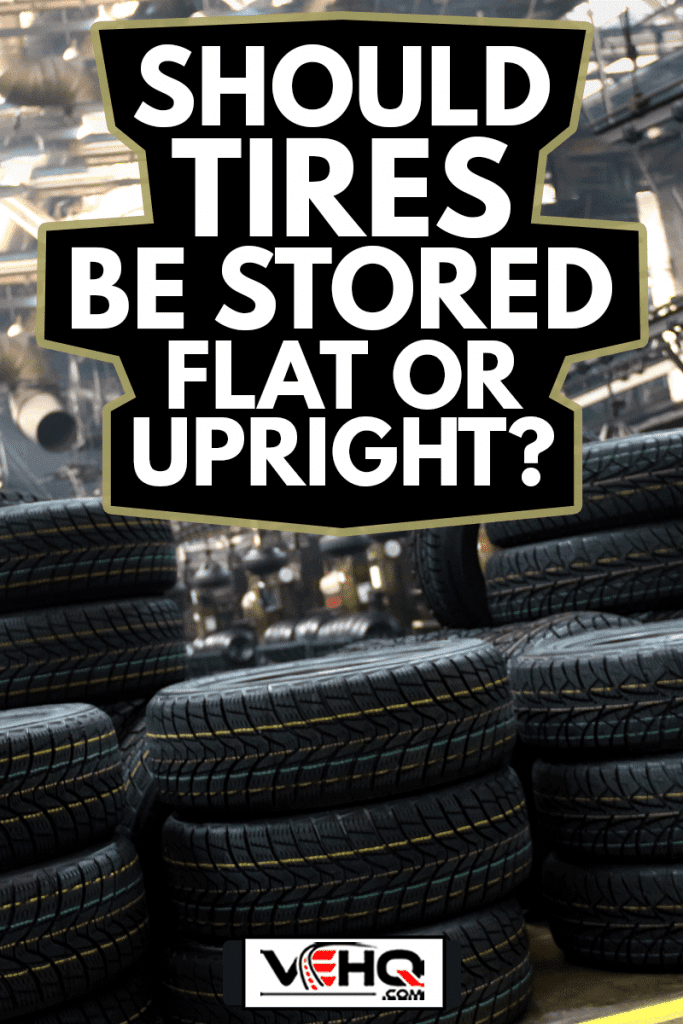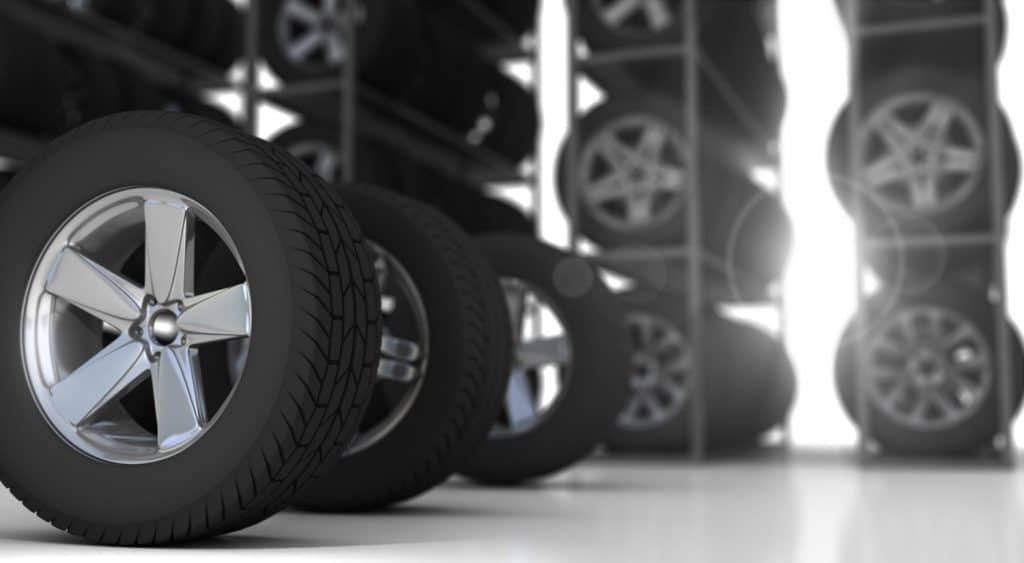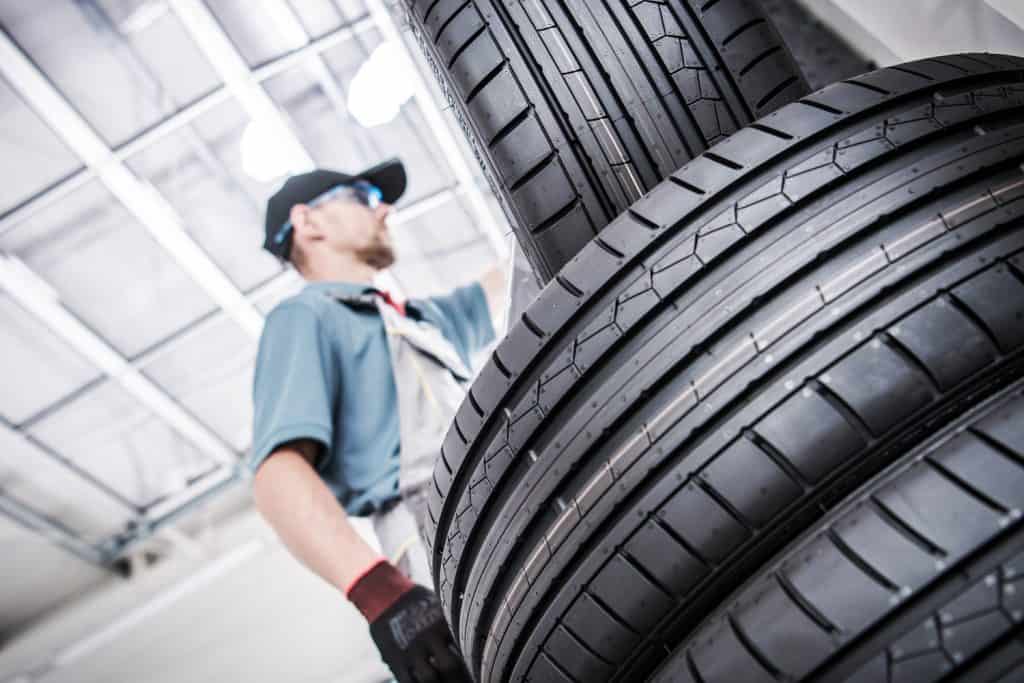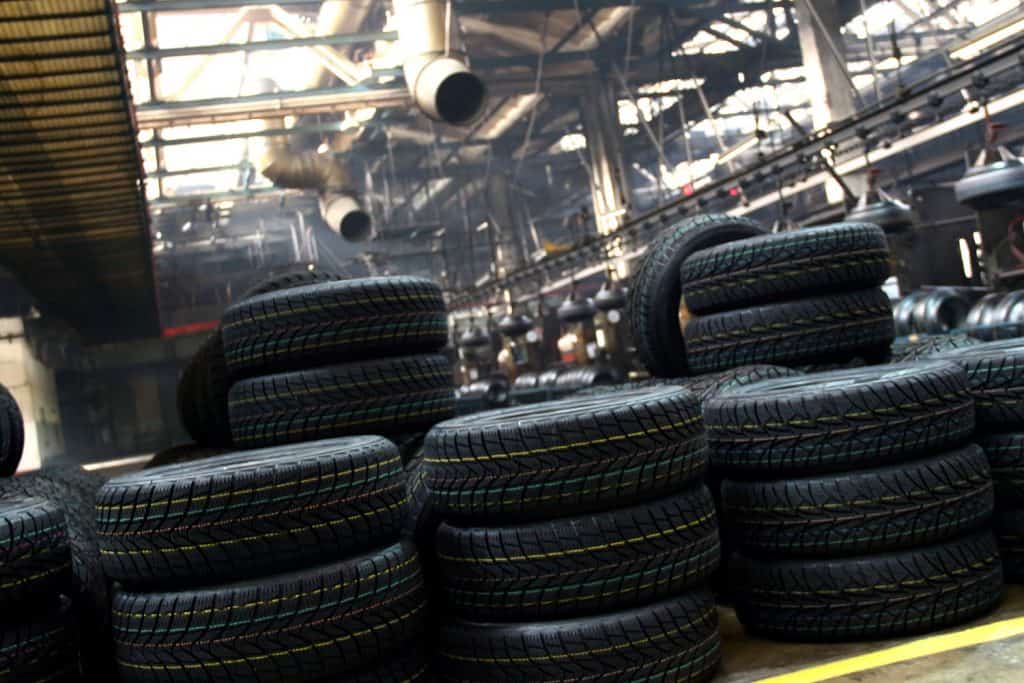Storing tires can help preserve their lifespan, allowing vehicle owners to make the most out of each one. But you may still have doubts about whether to store tires flat or upright. We've consulted with the experts in the vehicle and tire sectors, and here’s what they tell us.
Whether tires should be stored flat or upright depends on whether the tires have rims. Tires with rims should be stored flat or hung by the rim, and tires without rims should be stored upright.
It might seem relatively straightforward to store tires. But miss out on a few important details and the tires will deteriorate quickly while in storage. Keep reading to learn more about proper tire storage to prevent certain issues.

What Is The Proper Way To Store Tires?

Storing tires properly can help them last longer. Here are a few tips to help vehicle owners store their tires properly:
Clean Tires Before Storage
Removing traces of asphalt, dirt, brake dust, and small debris from tires is important before storage. If you overlook this cleaning technique, the rubber material may be at a higher risk than normal in absorbing oil, which can degrade the tire if exposed to hot temperatures.
Avoid petroleum-based products in cleaning tires. The harsh chemical in them can cause skin irritation. Additionally, petroleum may aggravate pre-existing eye, skin, and respiratory conditions. Petroleum may also increase the rate of tire degradation, reducing the tire's lifespan.
Here are the tools and steps needed to clean a tire properly:
What You’ll Need
- Bucket
- Microfiber towels
- Hose with spray nozzle
- Soft-bristled brush
- Non-abrasive cleaning products
- Tire wax
Steps To Clean Tires
- Rinse the loose dirt from the tire using the hose. Make sure to set the water pressure at the lowest level to avoid damaging the rubber material.
- Use the preferred non-abrasive cleaning solution (e.g., warm water and dish soap mixture) to rinse and scrub the tire's surface thoroughly.
- Use the soft-bristled brush to scrub the tire.
- Repeat steps 2 and 3 as needed.
- Let the tire air dry fully. Remove the excess moisture with microfiber towels if necessary.
- Apply tire wax to keep the tires from degrading while in storage.
Click here to see this Car Guys tire shine on Amazon.
Avoid The Sun
UV rays from the sun can ruin tires. The rubber material can crack and lose tensile strength from long-term sun exposure.
Additionally, certain UV rays can still penetrate walls. In turn, leaving tires exposed in indoor storage areas without proper coverage will still leave them unprotected.
Here are some tips to protect tires from harmful UV rays during storage:
- Use UV-protecting covers. Tire covers made with thick fabrics may help reduce light and UV rays from penetrating and deteriorating the rubber material.
- Stay away from openings. Put the tires away from doors and windows.
- Cover the tires with a tarp. A thick tarp can act as an extra layer of protection against UV rays.
Click here to see this tire cover on Amazon.
Ensure Proper Placement
Vehicle owners can store their tires stacked or in an upright orientation. But storing tires in incorrect positions may increase the risk of deterioration. Using the right placement and orientation can prolong the tires’ longevity during storage.
Stacked Tire Storage
Only store tires stacked or mounted on hooks if they have rims. Stacking tires or hanging them on hooks without the rims can cause deformation due to irregular weight distribution.
Upright Tire Storage
Store tires without rims in an upright orientation. Automobile owners should stack their vehicles’ tires through their sidewalls. This positioning will help prevent stains on the rubber that might otherwise accumulate from the white sidewall.
Vehicle owners should also place the unmounted tires on top of wood or other surfaces as opposed to laying them directly on concrete. The extra layer can help protect against moisture accumulation, which would otherwise cause the rubber to expand.
Select A Climate Controlled Environment
A cool and dry environment can help maintain tires during storage. A place with constant humidity and temperature levels is ideal for tire storage. Frequent dips and spikes in humidity and temperature may cause premature tire aging.
The basement can be an ideal choice to store tires. However, it's important to keep the tires away from objects that can cause significant highs and lows in temperatures such as furnaces and water tanks.
Also, avoid storing the tires near motors and electrical equipment. These items can produce ground-level ozone which reacts to sunlight to increase the rate of deterioration in certain objects, including tire rubber.
Failure to keep tires away from ozone-producing objects can break the rubber's polymer chains. In turn, the tires will have a higher-than-average risk of contracting dry rot.
Is It OK To Stack Tires?

It is perfectly fine to stack tires provided they still have rims. If you opt to stack your tires, it's recommended to rotate them at least once every four weeks. Doing so will help reduce the pressure on the different parts of the tires.
However, hanging the tires on hooks is a better option, as it avoids putting uneven pressure on different parts of the tires.
Click here to see this tire storage rack on Amazon.
Should Tires Be Stored Inflated Or Deflated?
Tires need to be at 50 percent inflation when stored. Moreover, it's important to secure the valve caps to prevent unwanted deflation.
Vehicle owners should also avoid using cleaning products with harsh chemicals before storing their tires. These compounds may cause corrosion, making the tires susceptible to cracks and deflation.
Do Tires Expire If Not Used?

Tires will last for about 6 to 10 years if properly stored in suitable environmental conditions. But take note that the period in which tires expire in storage is still roughly the same as when they’re used frequently.
The National Highway Traffic Safety Administration (NHTSA) recommends that vehicle owners replace their tires after the 6-year mark regardless of treadwear. Vehicle owners should check the age of their tires frequently to know the right time to install replacements.
For more information on the topic, take a look at this post: Do Tires Degrade Over Time? Even When Not Used?
How Can You Tell If A Tire Has Dry Rot?
Dry rot or sidewall cracking generally indicates tire rubber failure. The main sign of dry rot in tires is cracking in the rubber. Dry rot can also cause the following issues:
- Brittleness: The essential oils will seep out of the tires, making them weaker than before.
- Tread cracks: These cracks are signs of advanced dry rots and can adversely affect a car’s handling.
- Sidewall cracks: Might occur in specific areas around the tire or may extend to the hubcap.
- Color fading: Black tires may appear gray, which might also be in tandem with sidewall cracks.
Preventing tire rot also requires an understanding of the causes of this issue. Dry rot may come from the following conditions:
- Abrasive or corrosive products (e.g. motor oil and pool treatment solutions)
- Prolonged exposure to UV rays
- Freezing temperatures
- Under-inflation
- Ozone from electrical equipment
Will Tire Flat Spots Go Away?
Flat spots are flat and rigid areas that appear because the tires sit on one spot and in the same position for prolonged periods. These issues usually happen because of long-term parking or storage without moving the tires.
Thankfully, flat-spotting is temporary in most cases. Moving the tire to another spot or orientation should make the flat spots disappear after a few days or weeks.
This problem is also preventable by increasing the tire's inflation pressure based on the vehicle manufacturer's weight recommendations. Also, increasing the pressure slightly by +0.2 may help in reducing the likelihood of flat-spotting.
However, it's advisable not to exceed the recommended cold inflation pressure in tires, which vehicle owners should find in their automobile's owner's guide. Over-inflation can compromise the safety of passengers, especially when a tire blowout occurs.
In Closing

Storing tires properly can help them last longer provided they are stored correctly.
Store tires flat or stacked if they still have rims. Vehicle owners can also hang their tires if the rims are still in place. If there aren't rims, it's best to store the tires upright.
Before you go, check out this post if you have tire replacement concerns:



